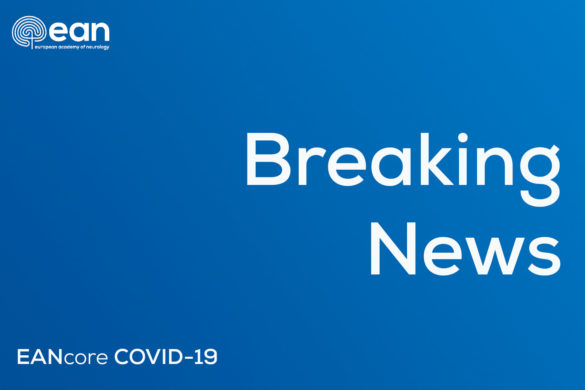Read on below for our highlighted selection of recent papers from the scientific press for January 2022.
For our highlighted Covid-19-related papers and studies, please explore the Breaking News category on EANpages, here.
- Erenumab versus topiramate for the prevention of migraine – a randomised, double-blind, active-controlled phase 4 trial
- Safety and efficacy of teriflunomide in paediatric multiple sclerosis (TERIKIDS): a multicentre, double-blind, phase 3, randomised, placebo-controlled trial
- Safety and efficacy of erythropoietin for the treatment of patients with optic neuritis (TONE): a randomized, double-blind, multicenter, placebo-controlled study
- The unfolded protein response in amyotrophic later sclerosis: results of a phase 2 trial
- Injection Into the Subscapularis for Hemiplegic Shoulder Pain: A Randomized, Double-Blind, Placebo-Controlled Trial
- Association of high-dose radiotherapy with improved survival in patients with newly diagnosed low-grade gliomas
Erenumab versus topiramate for the prevention of migraine – a randomised, double-blind, active-controlled phase 4 trial
The objective of this 24-weeks, randomized, double-blind, double dummy, controlled trial conducted on 777 patients with at least 4 migraine days per month was to compare oral topiramate to erenumab, a monoclonal antibody binding to the calcitonin gene-related peptide receptor, with regard to tolerability and to reduction from baseline in monthly migraine days. The results of this study indicate that the tolerability of erenumab is superior to that of topiramate, and that patients in the erenumab treatment group had a significantly greater reduction in monthly migraine days from baseline compared to patients in the topiramate group.
Reuter U, Ehrlich M, Gendolla A, et al. Erenumab versus topiramate for the prevention of migraine – a randomised, double-blind, active-controlled phase 4 trial. Cephalalgia. 2021 Nov 7:3331024211053571. doi: 10.1177/03331024211053571
Safety and efficacy of teriflunomide in paediatric multiple sclerosis (TERIKIDS): a multicentre, double-blind, phase 3, randomised, placebo-controlled trial
This multicentre, double-blind, phase 3, randomized, placebo-controlled trial assessed the safety and efficacy of teriflunamide in children with multiple sclerosis. The authors found no significant difference in time to first confirmed clinical relapse between teriflunomide and placebo (probably because more patients than expected switched from the double-blind to the open-label treatment period following the evidence of MRI activity), but demonstrated that the number of new or enlarged T2 lesions and the number of gadolinium-enhancing lesions per MRI was significantly reduced in the teriflunomide group. In terms of safety, teriflunomide was overall well tolerated.
Chitnis T, Banwell B, Kappos L, et al. Safety and efficacy of teriflunomide in paediatric multiple sclerosis (TERIKIDS): a multicentre, double-blind, phase 3, randomised, placebo-controlled trial. Lancet Neurol. 2021 Dec;20(12):1001-1011. doi: 10.1016/S1474-4422(21)00364-1.
Safety and efficacy of erythropoietin for the treatment of patients with optic neuritis (TONE): a randomized, double-blind, multicenter, placebo-controlled study
In this randomised, double-blind, multicenter, placebo-controlled study, the authors assessed the safety and efficacy of erythropoietin, a human cytokine with neuroprotective effects demonstrated in animal models, for the treatment of patients with optic neuritis as an adjunct to high-dose intravenous corticosteroids. The results of this study, which was conducted on 108 patients, demonstrate that erythropoietin provides neither structural nor functional benefits to the visual system following optic neuritis. From the safety point of view, erythropoietin was well tolerated in most patients. However, one participant developed a venous sinus thrombosis a few days after erythropoietin administration, which resolved completely after treatment with anti-coagulants.
Lagrèze WA, Kuchlin S, Ihorst G, et al. Safety and efficacy of erythropoietin for the treatment of patients with optic neuritis (TONE): a randomized, double-blind, multicenter, placebo-controlled study. Lancet Neurol 2021; 20:991-1000. doi: 10.1016/S1474-4422(21)00322-7.
The unfolded protein response in amyotrophic later sclerosis: results of a phase 2 trial
This multicenter, double-blind, phase 2 clinical trial with a futility design investigated the safety and efficacy of guanabenz, a molecule that has been shown to reduce neuronal death and prolong neuronal survival in in vivo models, in patients with amyotrophic lateral sclerosis (ALS) compared with a placebo group (to determine safety) and with a historical cohort of 200 patients with ALS (to determine efficacy). The results of this study demonstrate that guanabenz at dosages of 64 and 32 mg daily is effective in lowering the proportion of patients progressing to a higher stage of disease at 6 months, and in inducing a slower decline in daily living activities, particularly in patients with a bulbar onset. The proportion of adverse events was higher in the guanabenz than in the placebo group (particularly hypotension, fatigue drowsiness), but the number of serious adverse events was similar in the two groups. The promising results of this study indicate that a larger trial with a molecule targeting the unfolded protein response pathway without the alpha-2 adrenergic related side-effects profile of guanabenz is warranted.
Dalla Bella E, Bersano E, Antonini G, et al The unfolded protein response in amyotrophic later sclerosis: results of a phase 2 trial. Brain. 2021 Oct 22;144(9):2635-2647. doi: 10.1093/brain/awab167.
Injection Into the Subscapularis for Hemiplegic Shoulder Pain: A Randomized, Double-Blind, Placebo-Controlled Trial
This single-center, randomized, double-blind, placebo-controlled study investigated the efficacy of an ultrasound-guided lateral approach for botulinum toxin A injections into the subscapularis in patients with hemiplegic shoulder pain, which is one of the most frequent complication following a stroke. The authors found that patients receiving the botulinum toxin A injections had a significant decrease in pain and spasticity, as well as a significant improvement in shoulder abduction, pain-free passive shoulder internal rotation and quality of life compared to patients in the placebo group, without significant injection-related adverse events. The results of this study support the use of this approach to reduce pain and spasticity and improve the quality of movements in patients with hemiplegic shoulder pain following a stroke.
Botao T, Lang J. Ultrasound-Guided BoNT-A (Botulinum Toxin A) Injection Into the Subscapularis for Hemiplegic Shoulder Pain: A Randomized, Double-Blind, Placebo-Controlled Trial. Stroke 2021 Dec;52(12):3759-3767. doi: 10.1161/STROKEAHA.121.034049.
Association of high-dose radiotherapy with improved survival in patients with newly diagnosed low-grade gliomas
In this study, the authors explored the impact of the radiation dose on survival for patients with low-grade gliomas. They found a dose-response relationship, with a high-dose radiotherapy (54 Gy) being associated with improved survival. Interestingly, this study demonstrated that high-dose radiotherapy had a protective effect on overall survival and progression-free survival particularly in patients with IDH-mutant/1p/19q noncodeleted and IDH wild-type subgroups, which therefore should be considered for this treatment in future clinical practice.
Liu Y, Liu S, Li G, et al. Association of high-dose radiotherapy with improved survival in patients with newly diagnosed low-grade gliomas. Cancer 2021 Nov 15. Online ahead of print. doi: 10.1002/cncr.34028.











